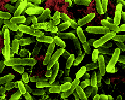An environmental engineer at
Lars Angenent, Ph.D., assistant professor of Chemical Engineering, and a member of the University's Environmental Engineering Science Program, has devised a microbial fuel cell which he calls an upflow microbial fuel cell (UMFC) that is fed continually. Unlike most microbial fuel cells, the chambers work on top of one another rather than side by side.
Angenent has created electricity with the device, which is about the size of a thermos flask, and says it has to be scaled up considerably to someday handle the two million or so gallons of wastewater it needs to treat to churn out enough power.
"We have proven we can generate electricity on a small scale," Angenent said. "It will take time, but we believe the process has potential to be used for local electricity generation.
"The upflow microbial fuel cell is a promising wastewater treatment process and has, as a lab-scale unit, generated electricity and purified artificial wastewater simultaneously for more than five months."
Angenent has filed a provisional

Jason He (left) and Lars Angenent inspect their microbial fuel cell. The researchers want to scale up the device for industrial use. David Kilper / WUSTL Photo
Angenent uses a carbon-based foam with a large pore size on which biofilm grows, allowing him to connect two electrodes in the anode and cathode chambers with a conductive wire.
In a hydrogen fuel cell a membrane separates the anode and cathode chambers. When hydrogen meets the anode electrode, it splits into protons and electrons, with protons going across the membrane to the cathode chamber, and electrons passing over the wire between electrodes to create a current. Oxygen is added to the cathode chamber, and on the electrode there is a reaction of electron plus proton plus oxygen to form water. Catalysts, such as platinum, are needed on both electrodes to promote the reactions.
"We are doing basically the same thing as is done in a hydrogen fuel cell with our microbial fuel cell," said Angenent, whose graduate student, Jason He has done all the research on the process. "We've found that the bacteria on the anode electrode can act as the catalyst instead of platinum."
"The bacteria form a biofilm on the anode electrodes, and what I want to do is optimise this process so that we get higher currents, which should allow us to scale up the system,' Angenent said.
Angenent said that producing energy from wastewater should be a high international priority because of population growth and worldwide depletion of energy resources. He noted that a bioelectricity generating wastewater treatment system in just one large food-processing plant could power as much as 900 American single-family households.




April 1886: the Brunkebergs tunnel
First ever example of a ground source heat pump?